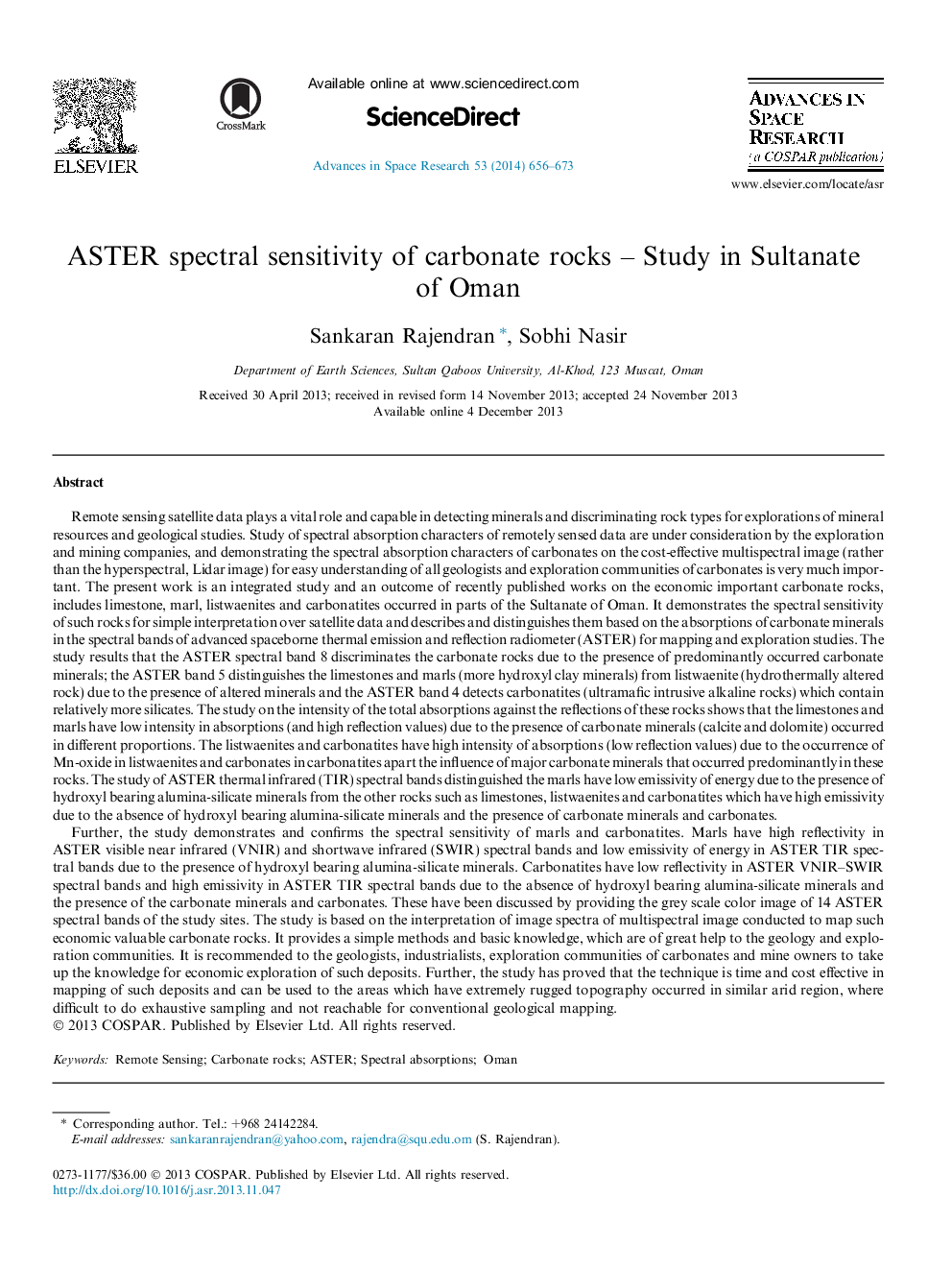| کد مقاله | کد نشریه | سال انتشار | مقاله انگلیسی | نسخه تمام متن |
|---|---|---|---|---|
| 1764079 | 1020041 | 2014 | 18 صفحه PDF | دانلود رایگان |

• Spectral sensitivity of carbonate rocks are studied using ASTER satellite data.
• Satellite image spectra of limestones, listwaenites, marls and carbonatites are studied.
• Evaluated the study in field and laboratory works.
• The study proved the remote sensing technique is time and cost-effective.
• The outcome of the study is useful to geologists and exploration communities.
Remote sensing satellite data plays a vital role and capable in detecting minerals and discriminating rock types for explorations of mineral resources and geological studies. Study of spectral absorption characters of remotely sensed data are under consideration by the exploration and mining companies, and demonstrating the spectral absorption characters of carbonates on the cost-effective multispectral image (rather than the hyperspectral, Lidar image) for easy understanding of all geologists and exploration communities of carbonates is very much important. The present work is an integrated study and an outcome of recently published works on the economic important carbonate rocks, includes limestone, marl, listwaenites and carbonatites occurred in parts of the Sultanate of Oman. It demonstrates the spectral sensitivity of such rocks for simple interpretation over satellite data and describes and distinguishes them based on the absorptions of carbonate minerals in the spectral bands of advanced spaceborne thermal emission and reflection radiometer (ASTER) for mapping and exploration studies. The study results that the ASTER spectral band 8 discriminates the carbonate rocks due to the presence of predominantly occurred carbonate minerals; the ASTER band 5 distinguishes the limestones and marls (more hydroxyl clay minerals) from listwaenite (hydrothermally altered rock) due to the presence of altered minerals and the ASTER band 4 detects carbonatites (ultramafic intrusive alkaline rocks) which contain relatively more silicates. The study on the intensity of the total absorptions against the reflections of these rocks shows that the limestones and marls have low intensity in absorptions (and high reflection values) due to the presence of carbonate minerals (calcite and dolomite) occurred in different proportions. The listwaenites and carbonatites have high intensity of absorptions (low reflection values) due to the occurrence of Mn-oxide in listwaenites and carbonates in carbonatites apart the influence of major carbonate minerals that occurred predominantly in these rocks. The study of ASTER thermal infrared (TIR) spectral bands distinguished the marls have low emissivity of energy due to the presence of hydroxyl bearing alumina-silicate minerals from the other rocks such as limestones, listwaenites and carbonatites which have high emissivity due to the absence of hydroxyl bearing alumina-silicate minerals and the presence of carbonate minerals and carbonates.Further, the study demonstrates and confirms the spectral sensitivity of marls and carbonatites. Marls have high reflectivity in ASTER visible near infrared (VNIR) and shortwave infrared (SWIR) spectral bands and low emissivity of energy in ASTER TIR spectral bands due to the presence of hydroxyl bearing alumina-silicate minerals. Carbonatites have low reflectivity in ASTER VNIR–SWIR spectral bands and high emissivity in ASTER TIR spectral bands due to the absence of hydroxyl bearing alumina-silicate minerals and the presence of the carbonate minerals and carbonates. These have been discussed by providing the grey scale color image of 14 ASTER spectral bands of the study sites. The study is based on the interpretation of image spectra of multispectral image conducted to map such economic valuable carbonate rocks. It provides a simple methods and basic knowledge, which are of great help to the geology and exploration communities. It is recommended to the geologists, industrialists, exploration communities of carbonates and mine owners to take up the knowledge for economic exploration of such deposits. Further, the study has proved that the technique is time and cost effective in mapping of such deposits and can be used to the areas which have extremely rugged topography occurred in similar arid region, where difficult to do exhaustive sampling and not reachable for conventional geological mapping.
Journal: Advances in Space Research - Volume 53, Issue 4, 15 February 2014, Pages 656–673